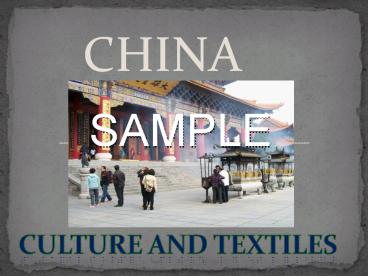CHINA - PowerPoint PPT Presentation
CHINA
For hundreds of years China stood as a leading civilization, outpacing the rest of the world in the arts and sciences. Background information . SAMPLE – PowerPoint PPT presentation
Title: CHINA
1
culture and textiles
- CHINA
SAMPLE
2
Background information
- For hundreds of years China stood as a leading
civilization, outpacing the rest of the world in
the arts and sciences.
SAMPLE
3
geography
China is 9.60 million square km in size
including Tibet, Hong Kong, Taiwan and
Macau. The countryside Ranges from coastal plains
to mountainous regions. The temperature ranges
from hot to extremely cold in different regions
of this diverse country.
SAMPLE
Buddhist temple
4
Workers skills and status
- The government does not support traditional
artisans but the growth in the tourism industry
and interest in the history of China and its
minority ethnic groups has allowed traditional
skills to be passed down from mothers to
daughters, developing thriving traditional
industries.
SAMPLE
Intricate and symbolic hand embroidery using silk
thread can take artisans hundreds of hours to
produce. the circular pattern of nine fish
represents the extended family and family life.
5
Hand weaving loom.
Fabric weaving, silk yarn Indigo dyed fabric
SAMPLE
Above a man uses a hand operated loom to
weave an intricate silk brocade. Hand made
brocades are very time consuming and expensive .
6
Indigo is the traditional dye used by the ethnic
minority groups. In the traditional pieces white
stitching was used to highlight designs.
- The indigo plant is a woody plant that grows to
about 2 metres in height in the steep hills of
southern China - The indigo leaves are fermented in a vat with
water, cellulosic fabric (eg cotton, flax) that
is immersed in the dye bath - A dark blue to black colour is achieved.
- Explain how traditional indigo dyes were made?
SAMPLE
PowerShow.com is a leading presentation sharing website. It has millions of presentations already uploaded and available with 1,000s more being uploaded by its users every day. Whatever your area of interest, here you’ll be able to find and view presentations you’ll love and possibly download. And, best of all, it is completely free and easy to use.
You might even have a presentation you’d like to share with others. If so, just upload it to PowerShow.com. We’ll convert it to an HTML5 slideshow that includes all the media types you’ve already added: audio, video, music, pictures, animations and transition effects. Then you can share it with your target audience as well as PowerShow.com’s millions of monthly visitors. And, again, it’s all free.
About the Developers
PowerShow.com is brought to you by CrystalGraphics, the award-winning developer and market-leading publisher of rich-media enhancement products for presentations. Our product offerings include millions of PowerPoint templates, diagrams, animated 3D characters and more.































